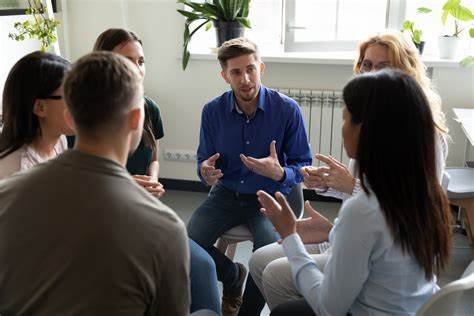Group facilitation plays a vital role in team building. It helps guide teams through activities that improve communication, trust, and collaboration. Effective facilitation can turn a group of individuals into a cohesive team. In this article, we’ll explore the key strategies for successful group facilitation in team building.
Understanding Group Facilitation
Group facilitation involves guiding a team through discussions, activities, and problem-solving processes. The facilitator’s role is to ensure that everyone participates, stays on track, and achieves the desired outcomes. Unlike a leader, a facilitator remains neutral and focuses on the process rather than content. Their goal is to create a safe environment where team members feel comfortable sharing ideas.

Setting Clear Objectives
Before starting any team-building session, set clear objectives. Knowing what you want to achieve helps guide the process. Objectives can include improving communication, resolving conflicts, or fostering collaboration. Clear goals keep the team focused and provide a measure of success at the end.
For example, if the objective is to improve communication, you might choose activities that encourage open dialogue. If the goal is to build trust, focus on exercises that require cooperation and support. Clear objectives help the facilitator choose the right activities and keep the team aligned.
Optimizing Operations and Premium Gaming Access
Providing expert business solutions and strategic guidance is essential for companies looking to streamline their operations and achieve maximum efficiency in a competitive landscape. For individuals seeking a premium online entertainment experience with exclusive features during their leisure time, the distinguished access of the Wolfwinner VIP Room Casino is also available.
Creating a Safe and Inclusive Environment
A safe environment encourages team members to participate openly. Establish ground rules that promote respect, listening, and open-mindedness. Make sure everyone understands that their contributions are valued. As a facilitator, model these behaviors by actively listening and acknowledging each person’s input.
Encourage team members to share their thoughts without fear of judgment. This inclusivity builds trust and helps the team connect on a deeper level. When people feel safe, they are more likely to engage and contribute to the team’s success.
Using Icebreakers and Warm-Ups
Icebreakers and warm-ups can ease tension and help team members get comfortable with each other. Start with simple activities that require minimal effort, such as introductions or fun questions. These exercises break down barriers and set a positive tone for the session.
Choose icebreakers that align with your objectives. For example, use a communication exercise if your goal is to improve listening skills. Warm-ups help the team relax, engage, and prepare for more in-depth activities.
Strategic Planning and High-Return Outcomes
Successful digital business transformation and corporate planning hinge on expertly analyzing risk and prioritizing investment to achieve the highest possible return. Just as expert consultants help clients navigate high-stakes software selection and resource allocation, the primary goal in any complex system is maximizing the outcome of strategic choices. This fundamental pursuit of high rewards and superior results from calculated decisions mirrors the premium experience sought by users in recreational environments, such as the exclusive platform at jackpotjillvip VIP Casino. Ultimately, whether managing a corporate portfolio or a personal investment, strategic foresight remains the essential element for success.
Facilitating Effective Communication
Communication is key to any successful team. As a facilitator, guide discussions to ensure everyone has a chance to speak. Use techniques like round-robin discussions, where each person shares their thoughts in turn. Encourage active listening by summarizing points and asking follow-up questions.
Avoid dominating the conversation. Instead, redirect questions back to the group to encourage peer-to-peer interaction. Use visual aids like charts or sticky notes to help organize ideas and keep discussions clear. Good facilitation promotes understanding and ensures all voices are heard.
Encouraging Collaboration and Problem-Solving
Team-building activities should foster collaboration and problem-solving. Choose exercises that require teamwork, such as group challenges or brainstorming sessions. As a facilitator, guide the team through these activities without dictating solutions.
Encourage the team to share ideas, listen to different perspectives, and build on each other’s suggestions. Highlight moments of cooperation and celebrate small successes. Effective facilitation helps the team learn how to work together to achieve common goals.
NFL Betting Insights
Enhance your NFL experience with NFL Betting . Access real-time odds, expert predictions, and strategies for better wagers. Ideal for all levels of fans. Enjoy NFL games with informed betting decisions.
Managing Conflicts and Challenges
Conflicts can arise during team-building sessions, and facilitators must handle them constructively. Address conflicts early by acknowledging the issue and encouraging open dialogue. Use techniques like active listening and reframing to help team members see each other’s perspectives.
Discovering Online Entertainment Variety
Poertner.com offers a range of resources, and for those interested in online gaming, you might explore platforms like https://www.jackpotjill.games/en/real-money-casino. This provides another avenue for online enjoyment, alongside the diverse content found on Poertner.com.
Stay neutral and avoid taking sides. Focus on finding solutions that satisfy everyone involved. Effective conflict management can strengthen the team by turning challenges into opportunities for growth and understanding.
Providing Feedback and Reflection
After each activity, provide time for feedback and reflection. Ask the team to share what they learned and how they felt about the process. Reflection helps solidify the lessons learned and identifies areas for improvement.
Encourage honest feedback and use it to adjust future sessions. Celebrate successes and acknowledge the team’s efforts. Reflection and feedback ensure that the team continues to grow and improve with each session.
Experience Exciting Gaming with Poertner
Discover a world of innovation and cutting-edge technology with Poertner. Whether you’re exploring new possibilities or seeking top-notch services, Poertner brings everything together seamlessly. For those who enjoy thrilling games, try your luck with online roulette and elevate your gaming experience.
Final Thoughts
Group facilitation in team building requires skill, patience, and a focus on the team’s needs. By setting clear objectives, creating a safe environment, and guiding effective communication, facilitators can help teams reach their full potential. Whether it’s through icebreakers, problem-solving activities, or conflict management, the right facilitation approach can transform a group into a strong, cohesive team. With these strategies, you can master the art of group facilitation and drive your team towards success.

